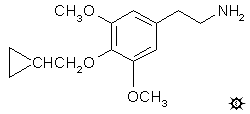
#37 CPM
CYCLOPROPYLMESCALINE; 4-CYCLOPROPYLMETHOXY-3,5-DIMETHOXYPHENETHYLAMINE
|
| [3D .mol structure] |
A suspension of 1.3 g LAH in 65 mL anhydrous THF under He was cooled to 0 °C with stirring, and 0.85 mL of 100% H2SO4 was slowly added. Then, with continued stirring, a THF solution of 2.7 g of 4-cyclopropylmethoxy-3,5-dimethoxyphenylacetonitrile in 50 mL THF was added dropwise. After the addition was complete, the mixture was brought to a boil briefly on the steam bath, cooled, and treated with sufficient IPA to destroy the excess hydride. Then there was added an amount of 15% NaOH sufficient to produce a loose filterable solid form of aluminum oxide. This was removed by filtration, and the filter cake washed with THF. The pooled filtrate and washes were stripped of solvent, and the residue was dissolved in dilute H2SO4, washed with 2x50 mL CH2Cl2, made basic with aqueous NaOH, and then extracted with 2x50 mL of CH2Cl2. After removal of the solvent, the residue was distilled at 128-140 °C at 0.4 mm/Hg to yield 2.5 g of a white oil. This was dissolved in 10 mL IPA, and treated with 30 drops of concentrated HCl which was just sufficient to demonstrate acidity as judged by external dampened pH paper. The addition of 25 mL anhydrous Et2O to the stirred solution allowed, in a few minutes, the product 4-cyclopropylmethoxy-3,5-dimethoxyphenethylamine hydrochloride (CPM) to spontaneously crystallize as a fine white solid. The yield was 1.8 g, and a second crop of 0.8 g was obtained from the IPA/Et2O mother liquors. The mp was 172-173 °C. Anal. (C14H22ClNO3) C,H.
DOSAGE: 60 - 80 mg.
DURATION: 12 - 18 h.
QUALITATIVE COMMENTS: (with 70 mg) I was surprised at the fast development of this drug, with the knowledge that it was a long-laster. Twenty minutes into it I was aware of some changes, and by the end of one and a half hours there was a complete plus three. The most remarkable property is the eyes-closed imagery. No, not just imagery but fantasy. It is not completely benign, but it locks into music with an extraordinary fit. I was at one moment keenly aware of my body touching the rug, the tactile aspects of my surroundings, and then I would find that my world was simply my personal sphere of reality that kept engulfing everything about me, all completely augmented by the music. Constructed by the music. I hoped that I wouldn't offend anyone else around me with this growing world of mine. Eyes open, there was not that much of note. Not much insight. Not much in the way of visuals. By the eighth hour an effort to sleep showed me how exposed and vunerable I was, and when I closed my eyes I needed my guards against this fantasy world. Even at the twelth hour there was no easy way to relax and sleep. Use higher dosages with caution.
(with 70 mg) There is a goodly amount of eyes-closed patterning but I found external sounds to be irritating. Voices, and even music, seemed to be intrusive. I didn't want to share my space with anyone. I was reminded of mescaline, in that I kept losing the awareness of the drug's role in my experience. Visual exaggerations are probably right around the corner. The residual effects were too much to ignore, but 100 milligrams of phenobarb at about the twelth hour allowed me to lie down quietly.
(with 80 mg) A wild day of profound philosophy, with discussions of the art of molecules, the origins of the universe, and similar weighty trivia. Much day-dreaming in erotic areas, but by and large, it went on a bit too long. I was tired.
EXTENSIONS AND COMMENTARY: In the literary world, the guy who is on your side, your leader, your champion, is the protagonist and the guy he battles, your enemy, is the antagonist. These same roles are played in the world of pharmacology, but the names are slightly changed. A drug which does the needed or expected thing is called the agonist rather than protagonist, but the drug that gets in its way is still called the antagonist.
The cyclopropylmethyl group plays an interesting role in the world of narcotics. There are numerous examples of opiates with a methyl group attached to a nitrogen atom which are famous for being valuable in producing analgesia and sedation. These run the gamut from natural alkaloids such as morphine and codeine, to synthetic variants such as Dilaudid and Percodan. And yet, with most of these narcotics, when the methyl on the nitrogen is removed, and a cyclopropylmethyl group put into its place, the agonist becomes an antagonist. Oxycodone (the active narcotic thing in Percodan) becomes Naltrexone, a drug that will immediately snap a heroin victim out of his overdose.
Cyclopropylmescaline (CPM) is a molecule that is very simply mescaline itself, with a methyl group removed from an oxygen atom and a cyclopropylmethyl group put on instead. Might CPM be not only inactive, but actually block the action of mescaline? Interesting concept. But it turned out to be entirely wrong.
The amphetamine analog of CPM should be easily made from the alkyl-ation of syringaldehyde with cyclopropyl chloride, followed by conventional reaction of the resulting aldehyde with nitroethane, and finally a reduction step. There is no reason to believe that the resulting compound 3,5-dimethoxy-4-cyclo-propyloxyamphetamine (3C-CPM) would be any shorter acting than CPM.
| [ |
[Main Index] | [Forward |

